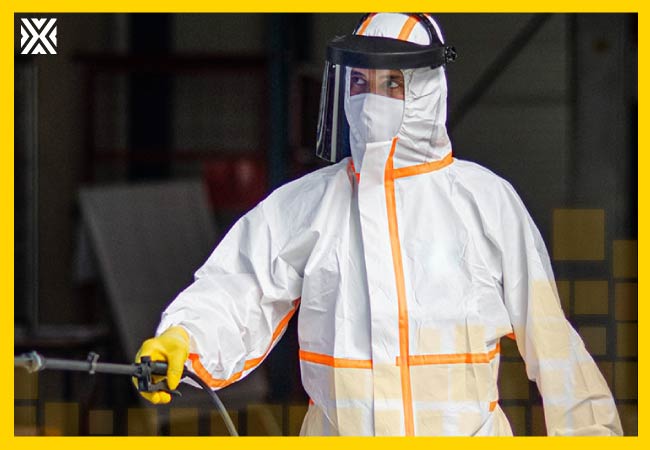Currency
November 01, 2020

Gloves are one of the most common forms of protection that is provided where the work involves the use of chemicals. In this context everything is either a chemical element or a combination of these and, as will be shown, there is virtually no chemical that cannot, under certain circumstance, cause damage to health should contact with the skin occur.
In most developed industrial environments, regulations on the use of gloves as protection consider gloves as a last resort, with other means (technical and organisation) taking priority. With certain limited exceptions gloves should only be used as protection against the residual chemical hazard.
There are several reasons for this: ● Personal protective equipment only protects the person wearing it, others may still be affected
● Achieving an adequate level of protection can be difficult, sometimes impracticable
● The performance of personal protective equipment against chemical hazards can be difficult to establish
● The performance is also dependent upon the correct use by the wearer, so compliance becomes a major concern
● Personal protective equipment can risk introducing other risks, e.g. due to loss of dexterity, hyperhydration of the skin causing dermatitis, etc.
● Personal protective equipment is always fail-to-danger

The latter aspect is something that experience suggests is not always adequately recognised. Effectively, we need to include in any risk assessment that involves gloves as protection against chemicals the risk that the gloves may fail – for one or more of several conditions – and the consequences of such failure. Where this would be acute and life changing, or even fatal, can we justify relying on gloves for the final protection?
“it is common to find gloves being worn for far longer than their real performance limits”
The way in which gloves work – and fail – is far more complex than many realise. The following is just a short overview, sufficient that when we consider the need for a structured approach to this the reader will recognise the reasons for caution and, perhaps, a more in-depth approach that is often common. Those who feel a need for a more in-depth explanation will find information on further reading at the end of this article.
There are four main reasons why gloves fail to protect the wearer: These are misuse, physical damage, degradation, permeation.
Misuse includes using the wrong glove for the chemical, using the correct glove but beyond its performance limits, and incorrect donning and removal techniques.
There is no glove that is what might be considered ‘universal’. Unfortunately, we find it common that a glove is selected according to the inadequate information on the safety data sheet or from a glove supplier’s catalogue. One common mistake is to assume that a woven glove, e.g. cotton or synthetic material, that has been coated with, say, polyurethane, is a chemical protective glove. The problem is that fibres from the coating may penetrate into the coating and act as pathways for the chemical to reach the skin.
No glove will provide infinitely long protection against any chemical. In fact, in most countries where regulations on gloves exist, the test requirement is for a maximum of eight hours. In reality, even with the optimum glove for the chemical selected the performance time may be hours, or even only a few minutes. As the failure due to the molecular transfer of the chemical through the glove is not readily detectable it is common to find gloves being worn for far longer than their real performance limits. There is more on this later in this article.
Misuse also encapsulates incorrect donning and doffing.
If unclean hands are inserted into a chemical protective glove this can exacerbate the damage that the soiling will do to the skin of the hands. Also, unless properly trained, most people will remove gloves in such a manner that the hands are contaminated with what is on the outside of the gloves, thus negating the protection that the gloves may have provided.
Forty-three hairdressers and apprentices were asked to remove gloves after washing hair. UV tracer was used to identify hand contamination before and after a training session on glove removal. All the participants (100%) had their hands contaminated during the first round.
In the second round 55.8% were contaminated. There were no significant differences between hairdressers and apprentices.” – Glove use among hairdressers: difficulties in the correct use of gloves among hairdressers and the effect of education, Oreskov KW, Søsted H, Johansen JD, Contact Dermatitis, 2015
When training on the use of gloves, it is common to find an over 50% failure rate even after the initial training.
Any physical damage to the glove as a result of working conditions will seriously affect the level of performance. The damage may be due to abrasion, cuts, splits and punctures, some so small that they are not readily detected by the naked eye. Should an assessment of the situation show the gloves are potentially subjected to physical damage, appropriate action is needed to protect them, possibly by the wearing of a glove offering the necessary physical protection over the chemical protective glove.
This is where the chemical reacts with and damages or destroys the chemical protective glove. Even where the damage is relatively minor it can have a significant effect on the duration over which the chemical protection will be achieved.
As there is no properly validated standard method for determining degradation, manufacturers use their own method. The result is that compatibility when evaluating different gloves can be difficult.
Degradation usually results in a physical change in the glove’s properties that is easily detected by a visible or sensory change in the gloves appearance or feel.
This is the most complex of the reasons for glove failure and the most difficult to determine with any accuracy. This is where the chemical in contact with the glove migrates through at a molecular level, emerging on the inside as a vapour. There is no visible or sensory change in the glove so the permeation is undetectable by the wearer. What is essential for the person deciding which glove to select and for how long it can be used for a particular chemical is to know how long it will take for permeation to occur. In the USA and Europe there are standard tests for permeation required by glove regulations. In the EU (and for the time being the UK) this is EN16523-1:2015. In the USA the equivalent standard is ASTM F 739. The test protocols are similar.
Unfortunately, the tests are laboratory based static tests. The permeation breakthrough test is conducted at what is described as room temperature, in the EU defined as 230C ±0C. Unfortunately, this does not necessarily match the operating temperature, particularly when relatively tight fitting gloves are worn. Table 1 shows how glove temperature can increase when a glove is donned. Table 2 shows the effect on permeation breakthrough time when a particular glove was tested with different chemicals at two different temperatures.
As can be seen, there is no consistent relationship between temperature and permeation breakthrough time. Indeed, as a result of a study testing real glove in-use performance conducted by the author in collaboration with Sunderland University our conclusion was that performance could vary enormously primarily due to differences in the nature of the task being carried out when the gloves were worn. An example of this was the factory where xylene was being used for several different tasks. The same glove type was being worn as protection. On checking, the manufacturer’s permeation breakthrough time according to the official test at the time was 37 minutes. In one task in-use testing showed no permeation breakthrough for two hours, in another permeation breakthrough in just five minutes! So, any decision as to which glove to use and how to use it must be primarily based on the task, i.e. what happens during the task and how does this affect hazard and exposure.
In most developed industrial environments, regulations on the use of gloves as protection consider gloves as a last resort, with other means (technical and organisation) taking priority. With certain limited exceptions gloves should only be used as protection against the residual chemical hazard.
There are several reasons for this: ● Personal protective equipment only protects the person wearing it, others may still be affected
● Achieving an adequate level of protection can be difficult, sometimes impracticable
● The performance of personal protective equipment against chemical hazards can be difficult to establish
● The performance is also dependent upon the correct use by the wearer, so compliance becomes a major concern
● Personal protective equipment can risk introducing other risks, e.g. due to loss of dexterity, hyperhydration of the skin causing dermatitis, etc.
● Personal protective equipment is always fail-to-danger

The latter aspect is something that experience suggests is not always adequately recognised. Effectively, we need to include in any risk assessment that involves gloves as protection against chemicals the risk that the gloves may fail – for one or more of several conditions – and the consequences of such failure. Where this would be acute and life changing, or even fatal, can we justify relying on gloves for the final protection?
“it is common to find gloves being worn for far longer than their real performance limits”
How gloves work and how they fail
The way in which gloves work – and fail – is far more complex than many realise. The following is just a short overview, sufficient that when we consider the need for a structured approach to this the reader will recognise the reasons for caution and, perhaps, a more in-depth approach that is often common. Those who feel a need for a more in-depth explanation will find information on further reading at the end of this article.
There are four main reasons why gloves fail to protect the wearer: These are misuse, physical damage, degradation, permeation.
Misuse
Misuse includes using the wrong glove for the chemical, using the correct glove but beyond its performance limits, and incorrect donning and removal techniques.
There is no glove that is what might be considered ‘universal’. Unfortunately, we find it common that a glove is selected according to the inadequate information on the safety data sheet or from a glove supplier’s catalogue. One common mistake is to assume that a woven glove, e.g. cotton or synthetic material, that has been coated with, say, polyurethane, is a chemical protective glove. The problem is that fibres from the coating may penetrate into the coating and act as pathways for the chemical to reach the skin.
No glove will provide infinitely long protection against any chemical. In fact, in most countries where regulations on gloves exist, the test requirement is for a maximum of eight hours. In reality, even with the optimum glove for the chemical selected the performance time may be hours, or even only a few minutes. As the failure due to the molecular transfer of the chemical through the glove is not readily detectable it is common to find gloves being worn for far longer than their real performance limits. There is more on this later in this article.
Misuse also encapsulates incorrect donning and doffing.
If unclean hands are inserted into a chemical protective glove this can exacerbate the damage that the soiling will do to the skin of the hands. Also, unless properly trained, most people will remove gloves in such a manner that the hands are contaminated with what is on the outside of the gloves, thus negating the protection that the gloves may have provided.
Forty-three hairdressers and apprentices were asked to remove gloves after washing hair. UV tracer was used to identify hand contamination before and after a training session on glove removal. All the participants (100%) had their hands contaminated during the first round.
In the second round 55.8% were contaminated. There were no significant differences between hairdressers and apprentices.” – Glove use among hairdressers: difficulties in the correct use of gloves among hairdressers and the effect of education, Oreskov KW, Søsted H, Johansen JD, Contact Dermatitis, 2015
When training on the use of gloves, it is common to find an over 50% failure rate even after the initial training.
Physical damage
Any physical damage to the glove as a result of working conditions will seriously affect the level of performance. The damage may be due to abrasion, cuts, splits and punctures, some so small that they are not readily detected by the naked eye. Should an assessment of the situation show the gloves are potentially subjected to physical damage, appropriate action is needed to protect them, possibly by the wearing of a glove offering the necessary physical protection over the chemical protective glove.
Degradation
This is where the chemical reacts with and damages or destroys the chemical protective glove. Even where the damage is relatively minor it can have a significant effect on the duration over which the chemical protection will be achieved.
As there is no properly validated standard method for determining degradation, manufacturers use their own method. The result is that compatibility when evaluating different gloves can be difficult.
Degradation usually results in a physical change in the glove’s properties that is easily detected by a visible or sensory change in the gloves appearance or feel.
Permeation
This is the most complex of the reasons for glove failure and the most difficult to determine with any accuracy. This is where the chemical in contact with the glove migrates through at a molecular level, emerging on the inside as a vapour. There is no visible or sensory change in the glove so the permeation is undetectable by the wearer. What is essential for the person deciding which glove to select and for how long it can be used for a particular chemical is to know how long it will take for permeation to occur. In the USA and Europe there are standard tests for permeation required by glove regulations. In the EU (and for the time being the UK) this is EN16523-1:2015. In the USA the equivalent standard is ASTM F 739. The test protocols are similar.
Unfortunately, the tests are laboratory based static tests. The permeation breakthrough test is conducted at what is described as room temperature, in the EU defined as 230C ±0C. Unfortunately, this does not necessarily match the operating temperature, particularly when relatively tight fitting gloves are worn. Table 1 shows how glove temperature can increase when a glove is donned. Table 2 shows the effect on permeation breakthrough time when a particular glove was tested with different chemicals at two different temperatures.
As can be seen, there is no consistent relationship between temperature and permeation breakthrough time. Indeed, as a result of a study testing real glove in-use performance conducted by the author in collaboration with Sunderland University our conclusion was that performance could vary enormously primarily due to differences in the nature of the task being carried out when the gloves were worn. An example of this was the factory where xylene was being used for several different tasks. The same glove type was being worn as protection. On checking, the manufacturer’s permeation breakthrough time according to the official test at the time was 37 minutes. In one task in-use testing showed no permeation breakthrough for two hours, in another permeation breakthrough in just five minutes! So, any decision as to which glove to use and how to use it must be primarily based on the task, i.e. what happens during the task and how does this affect hazard and exposure.









